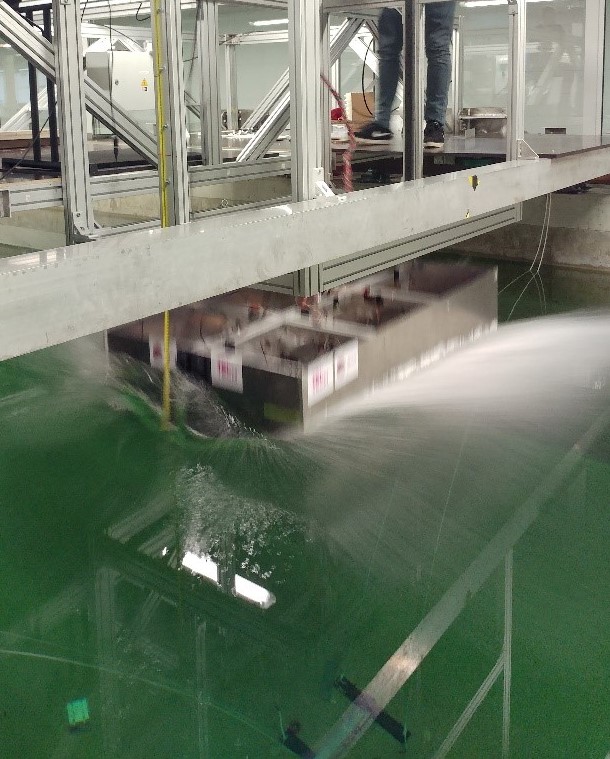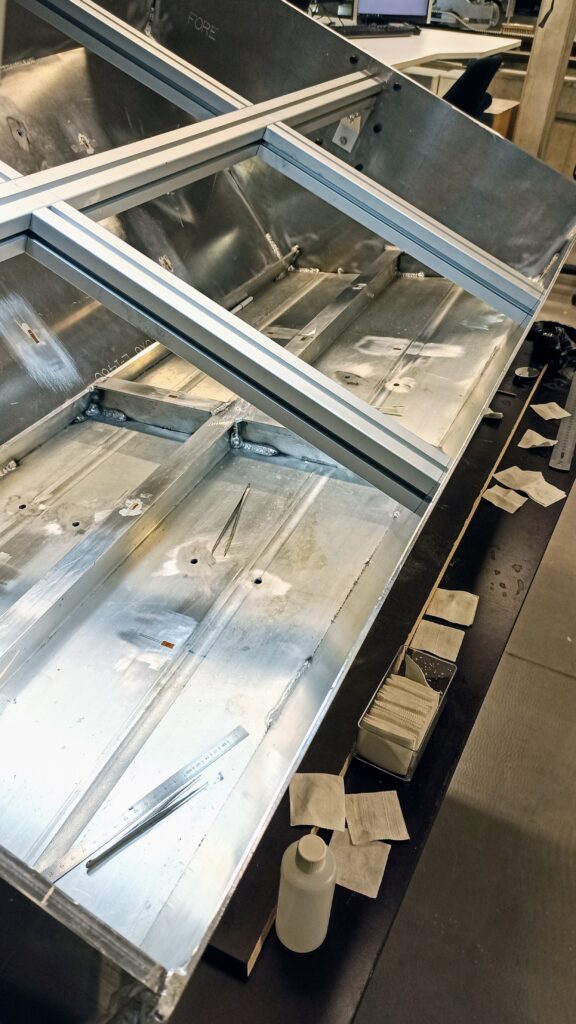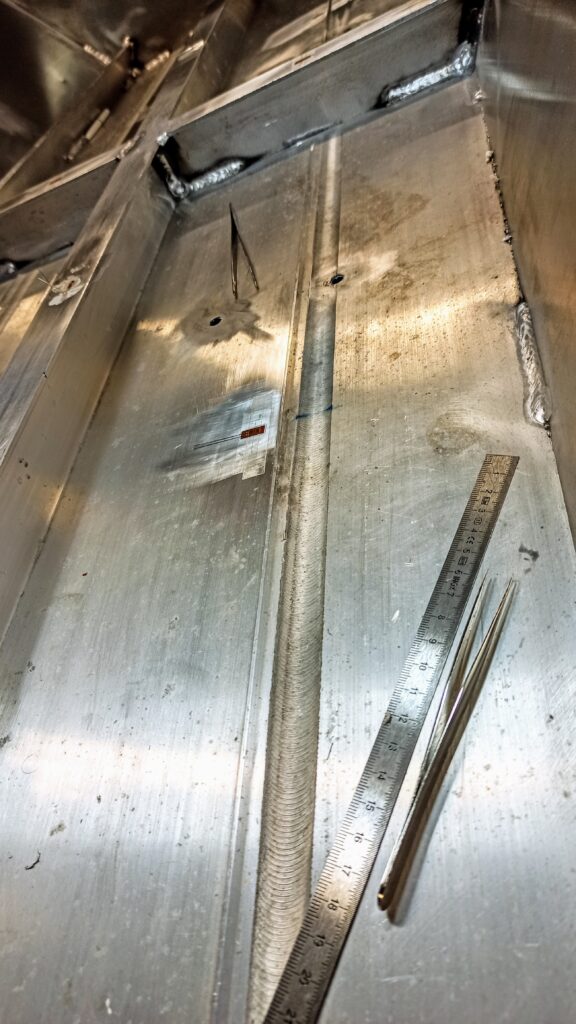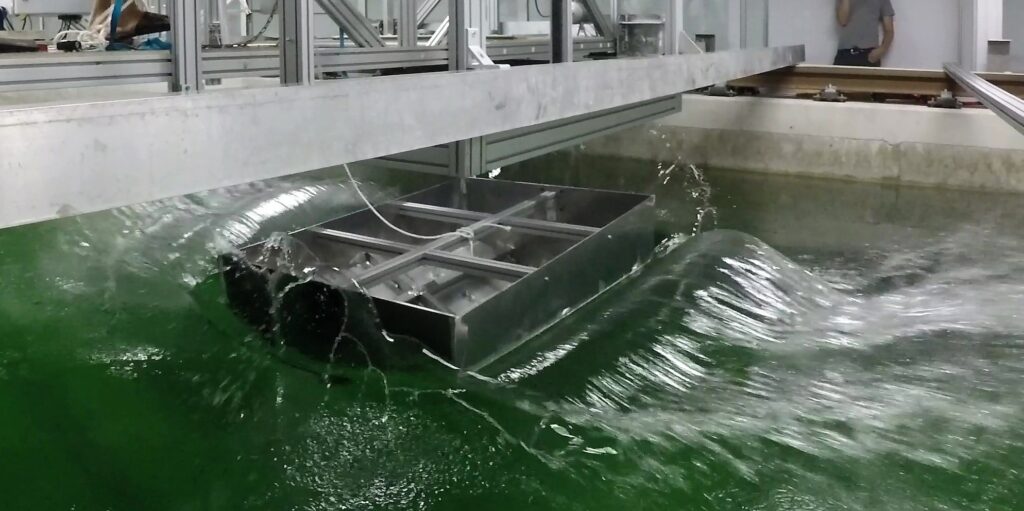
Ships are built to withstand a beating. Modern ship design is based on a research-backed understanding of all the forces at work when a vessel is put to sea. Doctoral student Saeed Hosseinzadeh employs the SCC towing tank to investigate the impacts of hydroelastic slamming.
One of the major challenges that naval architecture and marine engineers face is to accurately estimate the lifespan of large structures and to predict possible damages during the operation period. Vessels navigating through rough seas can experience great impact loads from waves slamming into the ship’s bow and stern. These may damage the structures of the ship despite the duration of the slamming being in the order of milliseconds. If the duration of the impact loads is much shorter than the natural period of the structure, it is referred to as hydroelastic slamming.
Despite their short duration, these slamming wave loads may damage ship structures, affect the performance of vessels and hinder the work of the crew serving on board. The dynamic response of the ship’s structures causes vibrations and material fatigue. Therefore, impact load predictions and resulting structural response and deformations must be considered in the design and operation of marine structures.
Doctoral student Saeed Hosseinzadeh specializes in the numerical and experimental investigation of hydrodynamics. His research spans a wide range of marine engineering problems and focuses on ship structures. Saeed researches fluid-structure interaction, computational and experimental fluid dynamics, ship hydrodynamics, hydroelastic slamming and reliability assessment of marine structures. He is a member of the Mechanics of Fluids and Structures Research Group at TalTech. Saeed’s supervisor is Senior Researcher Kristjan Tabri.
Furthermore, the new goal-based standards (GBS) issued by the International Maritime Organization (IMO) are changing the philosophy of how ships are designed, putting performance-oriented goals before purely technical regulations. The central element of optimal ship design will be a fluid-structure interaction model, where the ship’s behavior and its structural response under hydrodynamic loads are evaluated simultaneously. Marine designers and researchers around the world are looking for simple and effective approaches to determine dynamic forces and estimate probable structural deformations.
Fluid-structure interaction (FSI)
Fluid-structure interaction is a multiphysics synthesis between the laws that define fluid dynamics and structural mechanics. FSI describes interactions between a deformable or movable structure and a surrounding or internal fluid flow, which can be steady or oscillatory. One of the fluid-structure interactions coupling strategies that bear on naval applications is predicting hydrodynamic loading, including primary hull girder bending and predicting secondary loading such as slamming, whipping, and sloshing. Hydroelasticity is the naval counterpart of aeroelasticity, meaning that the fluid pressure acting on the structure modifies its dynamic state and, in return, the motion and distortion of the structure disturb the pressure field around it.
Free-fall drop tests
To study FSI under slamming loads, Saeed Hosseinzadeh designed a series of free-fall drop tests using a 1.5-meter elastic aluminum wedge representing a ship section, and the SCC towing tank. Such high-impact loads cannot be captured in regular towed-model tests.
Drop tests are carried out using a special frame. Two guide rails help the wedge fall vertically into calm water and allow variations in drop height and deadrise angle. The mass of the wedge is also varied throughout the tests. During the drop, vertical acceleration and pressure and deflection of the bottom surface of the wedge are measured using various sensors. The starboard side of the wedge, designed for analyzing the effect of flexural rigidity, is different from the port side – it is fitted with stiffened panels.
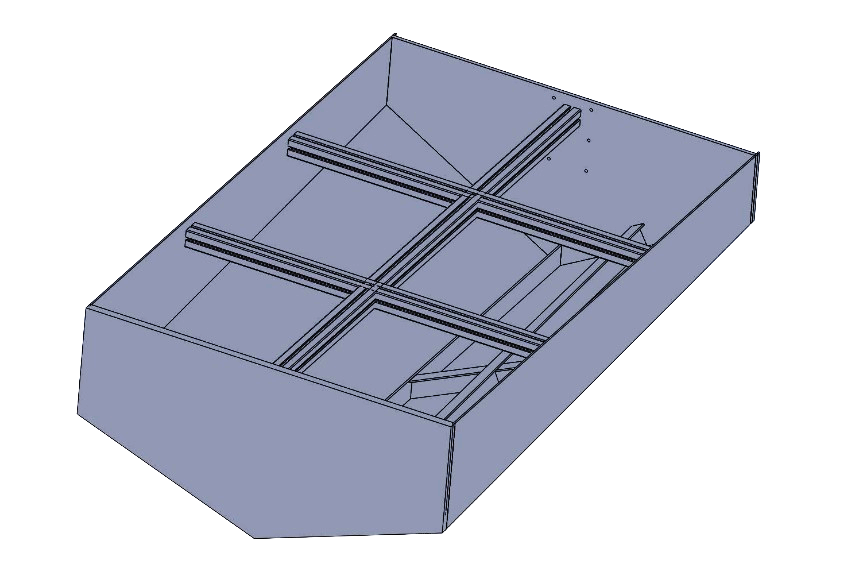
| Drop Test Wedge | |
|---|---|
| Length | 1500 mm |
| Breadth | 940 mm |
| Depth | 450 mm |
| Thickness of the bottom plate | 4 mm |
| Thickness of the end plate | 10 mm |
| Material | Al 5083-H111 |
Objectives
- Investigate slamming loads and pressures on a three-dimensional ship section with a focus on hydroelastic effects;
- compare a rigid body and an elastic ship section in symmetric and asymmetric conditions;
- provide an appropriate method for investigating structural deformation caused by impact loads.
Results
Experiments have shown that hydroelastic phenomena are highly important for marine structures and should be considered in both conceptual and detailed design. The results of the drop tests are intended to be used to validate numerical studies of hydroelasticity.
Studying vertical velocity in drop tests shows that the significance of hydroelasticity depends on the impact velocity, and for greater drop heights, the hydroelastic impact is substantial. Acceleration is greater at smaller deadrise angles. Similarly, the deflection of the bottom plate depends on the deadrise angle as expected. Hydroelasticity has to be considered in naval design especially when the angle between the free surface and the flexible wedge is small.
Personal research funding: Team grant
- PRG83 “Numerical simulation of the FSI for the dynamic loads and response of ships (1.01.2018−31.12.2022)”, Kristjan Tabri, Tallinn University of Technology.
- Financing: Estonian Research Council

